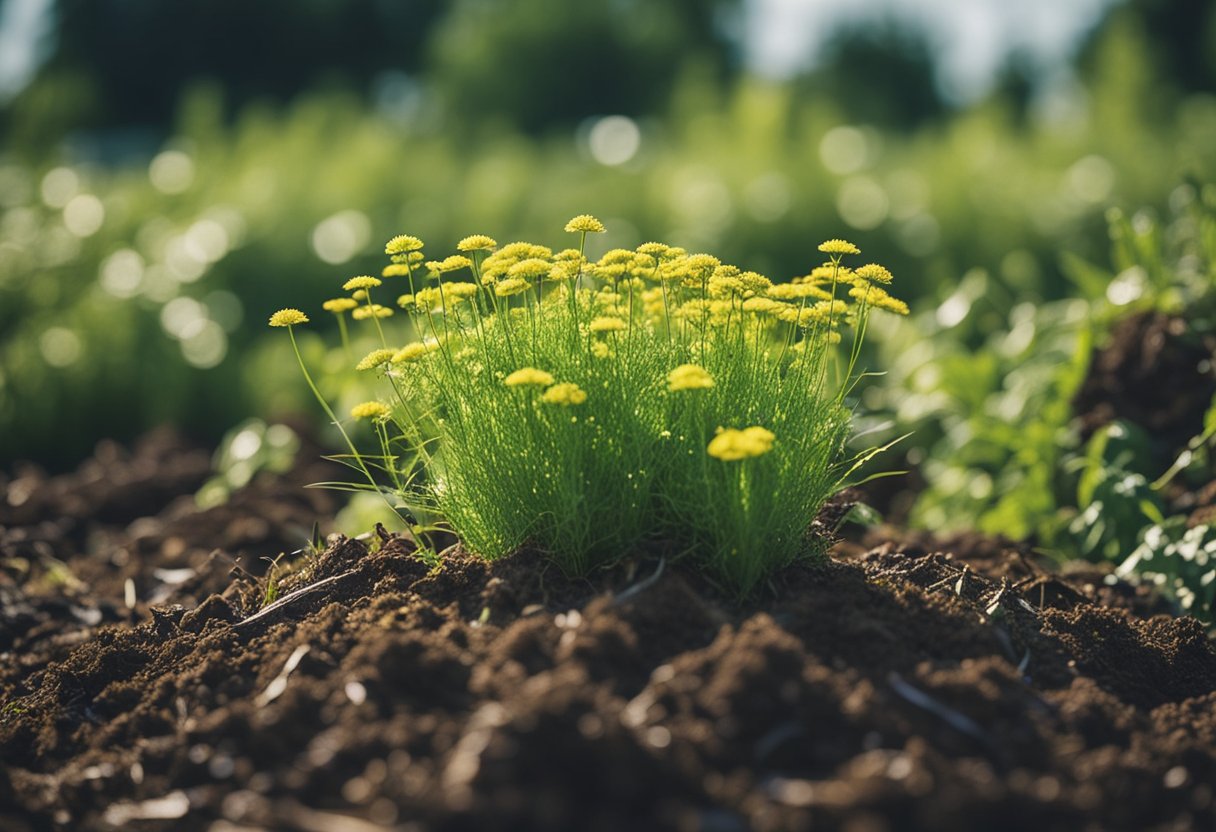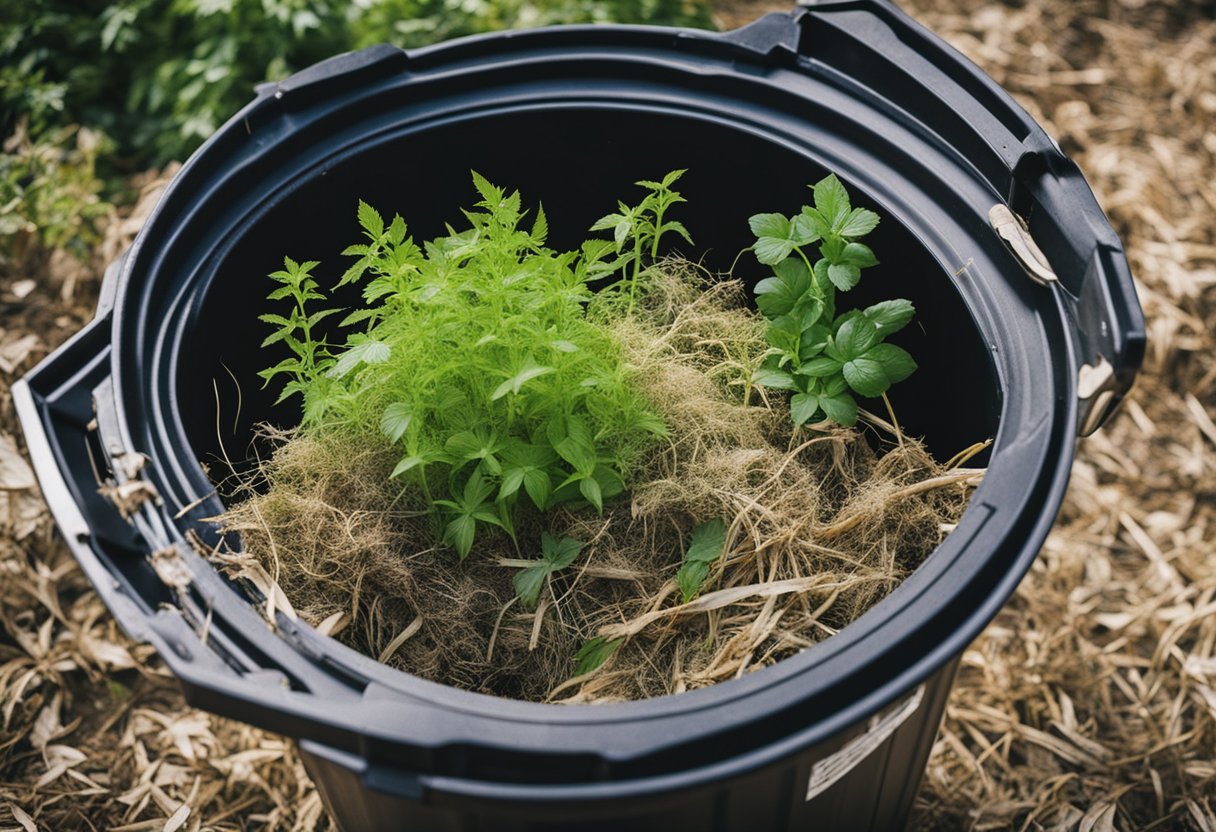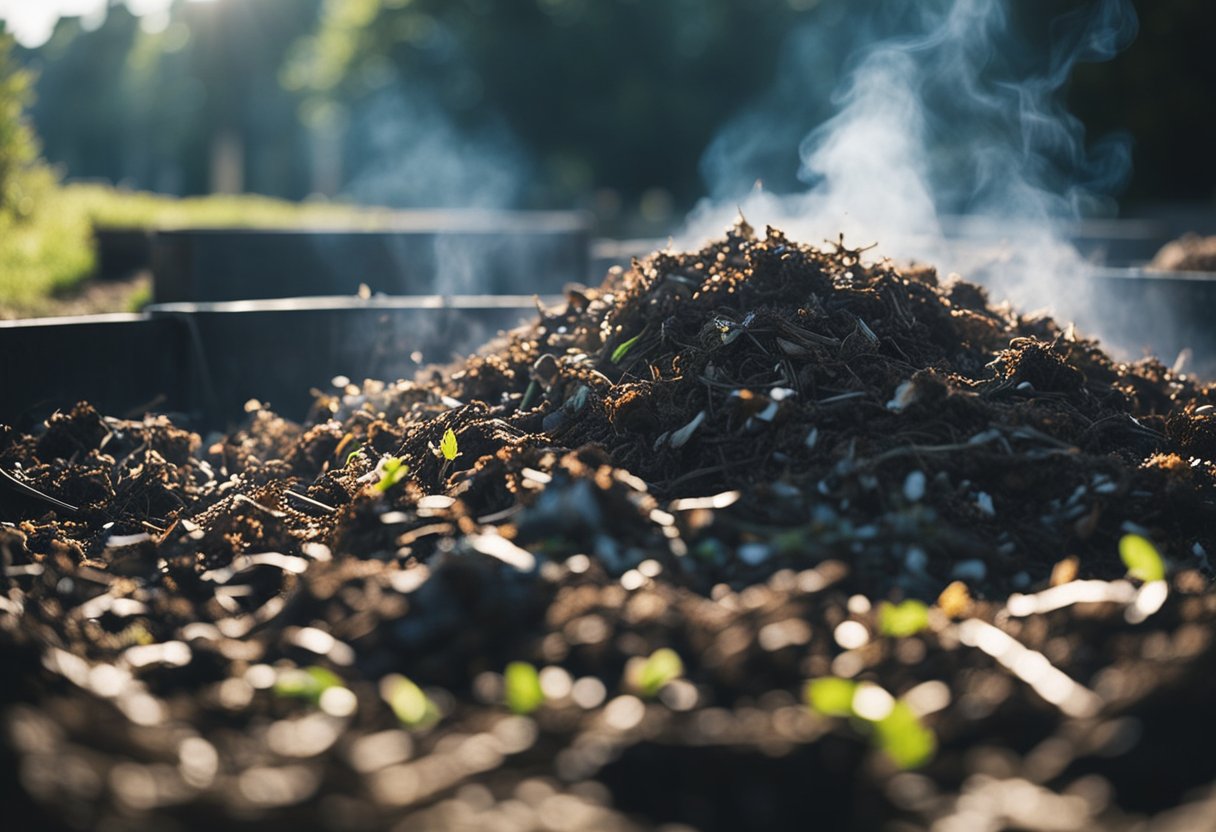As an Amazon Associate I earn from qualifying purchases.
At A Glance
Composting perennial weeds can be tricky and is not generally recommended for backyard composting systems. Perennial weeds are persistent and can regrow from small pieces of root or stem. If your compost pile does not reach high enough temperatures to kill off weed seeds and roots (at least 140°F or 60°C), composting perennial weeds could lead to the spread of these weeds when the compost is later used. However, hot composting systems that achieve higher temperatures can effectively compost perennial weeds.
Perennial weeds can be a real headache for gardeners. They have the ability to regrow from their roots, making them difficult to eradicate. But what about composting them? Can you add perennial weeds to your compost pile without risking the spread of weeds throughout your garden?
The answer is not a straightforward one. While it is possible to compost perennial weeds, it requires some careful consideration and attention to detail. Some perennial weeds, such as dandelions and plantain, can be safely composted as long as they are not allowed to go to seed. However, other weeds such as bindweed and quackgrass can be more problematic. These weeds have deep roots that can continue to grow even in compost piles, making it difficult to fully eradicate them. In some cases, it may be best to dispose of these weeds in the trash rather than risk spreading them throughout your garden.
If you do decide to compost perennial weeds, there are a few steps you can take to minimize the risk of spreading weeds. First, make sure to thoroughly chop up the weeds before adding them to your compost pile. This will help to break down the plant material more quickly and reduce the risk of regrowth. Additionally, try to avoid adding weeds to your compost pile when they are in the process of going to seed. This will help to prevent the spread of weed seeds throughout your garden. By taking these precautions, you can safely compost perennial weeds and reduce the amount of waste that ends up in your trash can.
Understanding Perennial Weeds

As a gardener, it is important to understand the difference between annual and perennial weeds. While annual weeds grow and die within one growing season, perennial weeds regrow every year from their roots.
Perennial weeds can be more difficult to get rid of than annual weeds because they are able to regrow from their roots. Some common examples of perennial weeds include couch grass, creeping buttercup, dandelions, bindweed, crabgrass, Japanese knotweed, nettles, buttercups, ground elder, and oxalis.
Perennial weeds can be particularly problematic in composting. Unlike annual weeds, which can be added to a compost pile without much concern, perennial weeds can regrow from any roots that are left behind in the compost. This can lead to the spread of weeds in your garden when you use the compost.
To avoid this problem, it is best to avoid composting perennial weeds altogether. Instead, it is recommended to dispose of them in the trash or to burn them. If you do choose to compost perennial weeds, it is important to take extra precautions to ensure that all roots are fully decomposed before using the compost in your garden.
In summary, perennial weeds can be a challenge for gardeners due to their ability to regrow from their roots. It is important to understand the difference between annual and perennial weeds and to take extra precautions when composting perennial weeds to avoid spreading them in your garden.
Composting Basics
Composting is a natural process of decomposition of organic matter. It is a great way to recycle organic waste and turn it into a nutrient-rich soil amendment. Composting is an eco-friendly and cost-effective way to manage organic waste and create a healthy soil ecosystem.
To start composting, you need a compost heap or bin, organic material, and time. The compost heap should be in a sunny location, protected from the wind, and have good drainage. The organic material should be a mix of green and brown materials. Green materials are high in nitrogen, such as grass clippings, vegetable scraps, and coffee grounds. Brown materials are high in carbon, such as dead leaves, straw, and wood chips.
The ideal ratio of green to brown materials is 1:2. This means that for every bucket of green material, you should add two buckets of brown material. The brown materials provide the structure for the compost heap, while the green materials provide the nitrogen that helps to break down the organic matter.
It is important to mix the compost heap regularly to ensure that all the organic matter is decomposing evenly. This also helps to aerate the compost heap, which is essential for the decomposition process. The compost heap should be kept moist but not too wet. If the compost heap is too dry, the decomposition process will slow down. If the compost heap is too wet, it can become anaerobic and start to smell.
In summary, composting is a simple and effective way to manage organic waste and create a nutrient-rich soil amendment. By following the basic principles of composting, you can create a healthy soil ecosystem and reduce your environmental impact.
Composting Weeds

As a gardener, I have often wondered whether I can compost perennial weeds. The answer is yes, but with some precautions. Composting weeds can be a great way to recycle organic matter and provide nutrients to your soil. However, if you compost weeds improperly, you may end up spreading weed seeds all over your garden.
Annual weeds can be composted without any problem, as long as they are not allowed to go to seed. Simply pull them up and add them to your compost pile. You can also add grass clippings and leaves to your pile, which will help balance the carbon-to-nitrogen ratio and speed up the composting process.
Perennial weeds, on the other hand, require a bit more attention. If you add them to your compost pile without killing the weed seeds and roots, you may end up with a pile of weed-infested compost. One way to ensure that your compost pile is free of weed seeds and roots is to use a hot compost pile. A properly maintained hot compost pile will kill weed seeds, as well as many other pathogens, so you can compost weeds without having to worry about them popping up in your garden beds.
To hot compost perennial weeds, follow these tips:
- Turn the pile frequently. All compost heaps have localized cool spots that are not hot enough to kill weed seeds. Turning the pile every few days will help distribute the heat and ensure that all weed seeds and roots are killed.
- Use a compost thermometer to monitor the temperature. The pile should reach a temperature of at least 140 degrees Fahrenheit to kill weed seeds and roots.
- Chop up the weeds into small pieces before adding them to the pile. This will help speed up the composting process and ensure that all parts of the weed are exposed to the heat.
- Avoid adding weed seedheads to the pile. These are the parts of the weed that contain the seeds and can survive the composting process.
- Do not add weed roots to the pile. These can survive the composting process and grow into new weeds in your garden.
If you do not have the time or resources to maintain a hot compost pile, you can still compost perennial weeds using a cool compost pile. However, it may take longer for the weed seeds and roots to break down, and you may end up with some weed-infested compost. To cool compost perennial weeds, follow these tips:
- Add the weeds to a separate pile from your regular compost pile.
- Cover the pile with a layer of mulch or soil. This will help smother the weed seeds and roots and prevent them from growing.
- Leave the pile to decompose for at least six months. This will give the weed seeds and roots enough time to break down and become compost.
In conclusion, composting weeds can be a great way to recycle organic matter and provide nutrients to your soil. However, it is important to compost them properly to avoid spreading weed seeds all over your garden. With a little bit of attention and care, you can turn your weeds into a valuable resource for your garden.
Hot Composting Method

I’ve found that the hot composting method is an effective way to compost perennial weeds. This method involves regularly turning the compost pile to ensure that it heats up to at least 145 degrees Fahrenheit. By maintaining high temperatures, the composting process will kill any weed seeds, as well as other pathogens.
One way to achieve high temperatures is to use a compost tumbler. These tumblers are designed to keep the compost aerated and evenly mixed, which helps maintain high temperatures. Another way to achieve high temperatures is to use a hot compost method, which involves layering green and brown materials in a pile and turning it regularly.
It’s important to monitor the temperature of the compost pile regularly to ensure that it stays above 145 degrees Fahrenheit. If the temperature drops below this threshold, it can allow weed seeds and other pathogens to survive and potentially germinate.
Overall, I’ve found that the hot composting method is a reliable way to compost perennial weeds. By maintaining high temperatures, this method can effectively kill weed seeds and other pathogens, resulting in nutrient-rich compost that can be used in the garden.
Nutrients and Soil Health
I always make sure to compost my garden waste, including perennial weeds, to improve the soil health and provide essential nutrients to my plants. Composting weeds can be a great way to recycle garden waste and create a nutrient-rich soil amendment.
Composting perennial weeds can provide an excellent source of nitrogen, phosphorus, and potassium, which are essential nutrients for plant growth. The composting process breaks down the weeds and releases these nutrients into the soil, making them available for plants to absorb.
In addition to providing nutrients, composting can also improve soil structure and water retention. Compost can help sandy soils retain moisture, while also improving drainage in clay soils. Adding compost to garden beds and flower beds can also help suppress weeds and reduce the need for synthetic fertilizers.
To ensure that perennial weeds are properly composted, it is important to maintain optimal conditions throughout the composting process. This includes maintaining a proper balance of green and brown materials, keeping the compost moist but not too wet, and turning the compost regularly to promote aeration.
I also like to use mulching as a way to suppress weeds and improve soil health. Mulching with organic materials such as leaves, straw, or grass clippings can help prevent weed growth and add organic matter to the soil. Mulching can also help regulate soil temperature, reduce soil erosion, and conserve water.
Overall, composting perennial weeds can be a great way to recycle garden waste, improve soil health, and provide essential nutrients to plants. By maintaining proper composting conditions and using organic mulches, gardeners can create a healthy and sustainable garden environment.
Preventing Weed Regrowth
As we discussed earlier, composting perennial weeds can be a risky move, as their root systems are capable of regenerating themselves even after being composted. To prevent weed regrowth, there are a few steps you can take.
Firstly, make sure that the compost pile is weed-free before you start adding your compostable materials. This means removing any weeds, especially perennial ones, that may be growing in the area where you plan to compost. You can use a shovel or a hoe to remove the weeds, making sure to get as much of the root system as possible.
Another option is to bag the weeds and dispose of them in the garbage. This may be necessary if you have a large amount of weeds or if you’re dealing with particularly stubborn perennial weeds.
If you choose to compost your weeds, make sure that your compost pile is hot enough to kill off any weed seeds or root systems. This means that your compost pile should be at least 140°F for several days. Turning the compost pile regularly can also help to distribute heat evenly and speed up the decomposition process.
It’s important to note that even if you take these precautions, there is still a risk of weed regrowth. To minimize this risk, it’s best to wait until the compost is fully decomposed before using it in your garden. This will ensure that any weed seeds or root systems have been broken down completely.
Environmentally Friendly Approaches
As a gardener, I am always looking for ways to minimize my impact on the environment. Composting weeds is a great way to reduce waste and create nutrient-rich soil for your garden. However, when it comes to perennial weeds such as dandelions or yellow dock, it’s important to take extra precautions to ensure that they don’t spread.
One environmentally friendly approach to composting perennial weeds is solarization. This involves covering the weeds with clear plastic and allowing the sun to heat up the soil, effectively cooking the weeds and killing their roots. Solarization can take several weeks to be effective, but it’s a great way to compost weeds without the use of chemicals.
Another approach is drowning, which involves placing the weeds in a bucket of water and leaving them to decompose. This method can take several weeks, but it’s a great way to compost weeds without the use of chemicals. Be sure to dispose of the water properly once the weeds have decomposed.
Using cardboard or straw as a mulch layer can also help to suppress weeds and prevent them from spreading. This is a great option for garden beds and can be used in conjunction with other composting methods.
Finally, adding worms to your compost pile can help to speed up the decomposition process and create nutrient-rich soil. Worms are great at breaking down organic matter and can help to turn your weed compost into a valuable resource for your garden.
Overall, there are several environmentally friendly approaches to composting perennial weeds. By taking the time to properly dispose of your weeds, you can create nutrient-rich soil for your garden while minimizing your impact on the environment.
Gardening Tips and Techniques
When it comes to gardening, one of the most important things to keep in mind is the health of your soil. Healthy soil means healthy plants, which in turn means a healthy garden. One way to improve the health of your soil is by composting.
Composting is a great way to turn your organic waste into a nutrient-rich soil amendment that can help your plants grow strong and healthy. However, when it comes to composting, many gardeners wonder if they can compost perennial weeds.
Perennial weeds are some of the most pernicious weeds in the garden. They can be difficult to get rid of and can quickly take over if left unchecked. However, with the right techniques, it is possible to compost perennial weeds and turn them into a valuable resource for your garden.
The key to composting perennial weeds is to make sure that the compost pile gets hot enough to kill the weed seeds and roots. A properly maintained hot compost pile will kill weed seeds, as well as many other pathogens, so you can compost weeds without having to worry about them popping up in your garden beds.
To ensure that your compost pile gets hot enough to kill all weed seeds and roots, follow these tips:
- Turn the pile frequently to ensure that all parts of the pile get exposed to the heat.
- Avoid adding any diseased or chemically treated weeds to the compost pile.
- Use a liquid fertilizer to help speed up the composting process.
- Layer your weeds with other organic matter, such as leaves or grass clippings, to help balance the carbon-to-nitrogen ratio and speed up the decomposition process.
By following these tips, you can compost perennial weeds and turn them into a valuable resource for your garden. Not only will you be reducing your organic waste, but you’ll also be improving the health of your soil and growing healthier, more productive plants.
